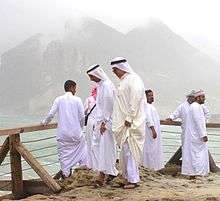Thawb
A thawb or thobe (Arabic: ثَوب / ALA-LC: thawb), dishdasha (دِشداشَة / dishdāshah), kandura (كَندورَة / kandūrah), khamis (Somali: khamiis / khamīs) in Somalia[1] or jalabiyyah in Libya, is an ankle-length Arab garment, usually with long sleeves, similar to a robe. It is commonly worn in the Arabian Peninsula, Iraq and neighbouring Arab countries. An izaar is typically donned underneath.
Background
The word thawb is the standard Arabic word for 'a garment'. It is the traditional Arabian clothing for men. It is sometimes spelled thobe or thaub. It is a tunic, generally long. The word is used specifically for this garment in Arab States of the Persian Gulf and some areas in the south of Egypt. There has been some debate regarding the correct length of the thawb.
Prevalence
The thawb is commonly worn by men in the Arabian Peninsula, Iraq, and other Arab countries in the Persian Gulf. It is normally made of cotton, but heavier materials such as sheep's wool can also be used, especially in colder climates in Iraq and Syria. The style of the thawb varies slightly among the various regions within the Persian Gulf. The sleeves and the collar can be stiffened to give a more formal appearance. Other names may be used for this garment. In Souraqia (Syria) and Oman, dishdasha is the most common word for the garment; in the UAE, the word kandura is used. In Morocco, the sleeves tend to be much shorter so that the thawb may seem more like a long T-shirt and is locally called gandora. Also the neck tends to be more open than in its Saudi counterpart and is often embroidered as is the breast pocket. Also it might lack buttons altogether.
The term thawb is also used to refer to similar women's garments.[2] The traditional Palestinian woman's long tunic is called thawb. Another example is a very long, oversized woman's garment with a heavily embroidered front panel and billowing back, also known as a Khaleeji dress, which is most commonly seen in the West worn for performance of the Saudi women's social-style dances, in which manipulation of the large thawb is a key component.
This garment is also known as Kanzu in Swahili, and is commonly worn on the Swahili Coast by Swahili men.
Name variations
| Region/country | Language | Main |
|---|---|---|
| Arab World | Arabic dialects | Thawb |
| Syria, Oman, Kuwait, Iraq | Syrian Arabic, Omani Arabic, Kuwaiti Arabic, Iraqi Arabic | دِشداشَة (Dishdaashah) |
| UAE | Emirati Arabic | كَندورَة (Kandoorah) |
| Maghreb | Maghrebi Arabic, Berber | Gandora, Djellaba, Aselham |
| Swahili Coast | Swahili | Kanzu |
| Senegal | Senegalese | Kaftan |
| Libya | Libyan Arabic | Jilaabiyah |
| Egypt | Egyptian Arabic | Galabeyya |
| Bangladesh | Bengali | Thub |
| Somalia | Somali | Khamiis or Jelabiyad |
| Ethiopia | Amharic | Jelebeeya |
| Eritrea | Eritrean | Jehllubeeya |
| Indonesia | Indonesian | Jubah, Gamis |
| Iran, Pakistan | Farsi, Urdu | جُبّه (Jubbah) |
| Israel | Hebrew, Yiddish | Bekishe |
| Turkey | Turkish | Cübbe |
Other occasions
A thawb or thaub can sometimes be worn with what is known as "besht" [بشت] or in other parts of the Arabian Peninsula as "abat" [عباة] which means a robe. It is usually worn in ceremonial occasions or by officials. Besht, can be worn in a wedding, Eid, and funerals. It may refer to a status of wealth and royalty, or sometimes a religious position. It was originally manufactured in Syria, Iraq and Jordan, and it is usually worn in Jordan, Syria, Iraq and the Arabian peninsula.
According to H. R. P. Dickson, in "The Arab of the Desert",[3] 1949, Bedouin women would mount a brightly colored thobe on a pole in front of the tent in order to welcome home a traveler or an important person coming to visit.[4]
See also
- Agal - Arabian headdress
- Islam and clothing
- List of types of sartorial hijab
- Jellabiya
- Senegalese kaftan
- Shalwar Kameez
References
- ↑ Michigan State University. Northeast African Studies Committee, Northeast African Studies, Volume 8, (African Studies Center, Michigan State University: 2001), p.66.
- ↑ "The Gown That Steals Your Heart." Written by Kay Hardy Campbell, Art by Leela Corman. Aramco World. March–April 2016. Volume 67 (2), pages 24-25.
- ↑ Dickson, H.R.P. The Arab of the Desert (RLE Saudi Arabia): A Glimpse into Badawin Life in Kuwait and Saudi Arabia. 2015. http://www.worldcat.org/oclc/919302946
- ↑ "The Gown That Steals Your Heart." Written by Kay Hardy Campbell, Art by Leela Corman. Aramco World. March–April 2016. Volume 67 (2), pages 24-25.

.jpg)